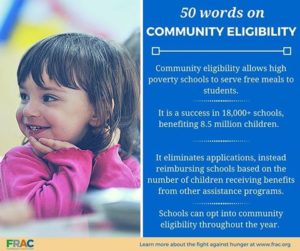How can more hungry students access free school meals? Community eligibility helps communities bypass bureaucratic obstacles to ensure children are getting the nutritious meals they need to stay healthy and ready to learn. Here is a go-to guide for answering your questions about community eligibility.
What is community eligibility?

Benefits include increased student participation, which improves both student achievement and school meal finances. School districts can invest any additional revenue in higher quality meals and staff training. Community eligibility also decreases the administrative burden on school staff and on parents and caregivers, eliminates unpaid meal fees, and facilitates the use of alternative breakfast models, such as breakfast in the classroom or “grab and go” meals.
How can I find out if my school can participate in community eligibility?
Any district, group of schools in a district, or individual school with 40 percent or more “identified students” can participate.
Identified students include children who are:
- living in households that receive Supplemental Nutrition Assistance Program (SNAP), Temporary Assistance for Needy Families (TANF), or Food Distribution Program on Indian Reservations (FDPIR) benefits, and in some states and areas, Medicaid benefits;
- homeless;
- migrant;
- enrolled in Head Start; or
- in foster care.
To find eligible schools in your area, search FRAC’s community eligibility database.
Schools in my area are eligible — what can I do?
Start by checking in with your school district’s school nutrition director and share this fact sheet (pdf) on the benefits of community eligibility.
One of the most effective ways to promote community eligibility is to provide information to school officials so they can learn more about this important program, and its benefits to the students and the school as a whole. Community eligibility has successfully reached more than 8.5 million children in over 18,000 schools across the nation since its rollout in the 2014–2015 school year. Read FRAC’s Advocate’s Guide to Promoting Community Eligibility (pdf) for additional resources.
Schools in my area aren’t eligible – what now?
For schools that are close to the eligibility threshold, advocates can make sure school districts are identifying all students who qualify for free meals without an application. For example, school nutrition directors can collaborate with homeless education coordinators and local shelters to compile lists of students to be certified for free meals.
Advocates can also work with school districts to conduct SNAP outreach to increase the number of eligible families participating — children can be directly certified based on their enrollment in SNAP. All across the country, there are children eligible for SNAP who aren’t yet participating. If the percentage of qualifying students increases, your school could qualify for community eligibility!
How else can I get involved in the fight to end hunger?
You can explore other ways to advocate for the expansion of school meals, especially school breakfast. Many schools with 60 percent or more free and reduced-price eligible students, even if not eligible for community eligibility, can offer free breakfast more broadly through Provision 2 or non-pricing.
Provision 2 is a longstanding federal option designed to reduce paperwork and simplify the logistics of operating school meals programs. With non-pricing, schools continue to count and claim federal dollars for school meals but simply do not collect fees from students. FRAC’s Offering Free Breakfast to All Students (pdf) offers more information on finding the best approach for your school to fight hunger.


